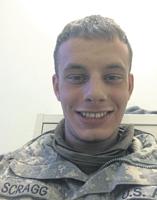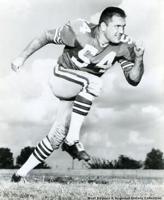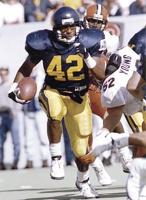NEW ARRIVAL: Brantley Gilbert says his baby boy was born on his tour bus last weekend because nobody figured he was coming so soon. The ÃÛÁÄÖ±²¥œOver …
Six former Marshall football players have made the 53-man rosters of five teams in the NFL, including a trio of 2024 undrafted free agents who…
All 32 NFL teams have gotten a fresh start with the start of preseason training camps, and a handful of former Marshall football players were …
The short summer vacation is over for NFL players. ItÃÛÁÄÖ±²¥™s time to begin the journey to Super Bowl 59.
ZACHARY MICHAEL SCRAGG, 30, of Barboursville, our beloved father, fiancée, son, brother, uncle, nephew, cousin and friend departed this life M…
MORGANTOWN, W.Va. (WV News) ÃÛÁÄÖ±²¥” Trust me.
Major Harris did more than make one run against Penn State in his career that is being honored Saturday when West Virginia takes on No. 11 Oklahoma State at Mountaineer Field by becoming the fifth player in school history to have his football number retired.
The others, dare you forget, are Sam Huff, Ira Errett Rodgers, Bruce Bosley and two weeks ago Darryl Talley.
I know, all you've seen of Major's are clips the run from that magical undefeated 1988 regular season, a season that brought West Virginia to the brink of a national championship many outside this state and everyone within this state thought they would win against Notre Dame.
The Irish, however, won the game and did it probably the only way they could, with Harris injuring his shoulder in the first quarter, an injury that changed history, just as the man they simply call "The Maj" had done with his very presence at quarterback for WVU.
Harris played the game out but his coach, Don Nehlen, and his teammates all maintain they had to change their entire approach and game plan as he was limited in what he could do.
Uninjured, there wasn't anything he couldn't do.
If they didn't invent the phrase "He could do it all" for Major Harris, they should have, for he bordered upon the prototype college quarterback ... a dozen, probably two dozen years before it became the prototype.
But first back to "The Play", a 21-yard run that started in the wrong direction but got to the intended termination point ÃÛÁÄÖ±²¥” the Penn State end zone ÃÛÁÄÖ±²¥” simply because Harris could do whatever he wanted to do with a football in his hands.
You've seen the clip. Harris had called an option left, then somehow made his only mistake of that game, if not the season, when he went right. If you look closely at the film, he hesitates briefly as if it the idea of going back toward the left ÃÛÁÄÖ±²¥” where his blockers were ÃÛÁÄÖ±²¥” was being considered.
But Harris knew that wouldn't work, so he went at it alone to the right, making moves you've you only seen those slithery "little guys" like Noel Devine or Patrick White make. He made one miss, a second, a third, a fourth and a fifth before winding up in the end zone standing up.
You saw the play. But do you know how Jack Fleming, who was as good in the broadcast booth as Harris was on the field, called the play.
"Here's Harris in trouble, stiff arms a would-be tackler, comes out of it at the 25, the 20, goes around a defender at the 15, the 5. Touchdown, West Virginia. He did it! What a move he made on the first tackler. What move he made on the second, on the third, and he gallops in for the touchdown. He takes it all the way in."
He turned it from a broken play for West Virginia into broken hearts for Penn State fans who weren't used to the Mountaineers ever doing anything right against them, as evidenced by the fact that before that win WVU had lost 28 its previous of its 29 games to the Nittany Lions, including 25 in a row.
But Major Harris and a team bent on making history put an end to such foolishness, adding to the legacy "The Play" would leave.
But there was so much more of Major Harris, as he was a big part of changing the way the position of quarterback would be played in football.
He wasn't the first scrambling quarterback. He isn't even remembered as the best, probably more because he was before his time when you enter in the NFL.
See, the players who rank at the top of running, scrambling quarterbacks on all those lists of the all-time best went on to NFL fame, beginning with Fran Tarkenton of the Minnesota Vikings out of Georgia.
It started in college ball even before Tarkenton as Navy's Roger Staubach earned the nickname of "Roger the Dodger" with his electrifying scrambles, the ability allowing him to eventually invent "The Hail Mary" pass when he was with the Dallas Cowboys.
Tarkenton passed for 47,003 yards and 342 touchdowns in the NFL and ran for 3,674 yards with 32 rushing touchdowns, becoming an MVP and a three-time Super Bowl quarterback, even though like Harris, that championship avoided him.
Staubach, of course, also went on to become a Hall of Famer.
But, for the most part, Tarkenton stood alone as the league would be dominated over the next couple of decades like Dan Marino and Dan Fouts. We're not saying the answer was quarterbacks named Dan, but drop back QBs who used their arms rather than mobility to advance the ball down the field.
In the mid-1980s, however, as Harris was emerging at WVU, the pros were being invaded by the likes of Randall Cunningham and Steve Young and would go on to Steve McNair and Michael Vick, mobile quarterbacks who were taking over the game.
Today you have as many mobile QBs as dropback QBs and a player like Lamar Jackson, who won a Heisman Trophy at Louisville, could also win an NFL MVP award, just as Patrick Mahomes had done with a different, but no less mobile, style with Kansas City.
Major Harris, though, was ahead of his time.
He left WVU a year early, which proved to be a mistake even though he had already authored a career that would earn him College Hall of Fame induction, but the pros did no more than draft him in the 12th round.
He never played an NFL down and that worked against his national legacy, but those in West Virginia ÃÛÁÄÖ±²¥” fans and teammates ÃÛÁÄÖ±²¥” know that he was the most exciting player they ever saw.
How deserving is Major Harris of having his number retired?
Well, there was this Tweet from a day ago that also carried a clip of the run against Penn State:
3 right sticks and a score agoÃÛÁÄÖ±²¥¦ Complete. Perfect. Devine. Number 9! #GOAT https://youtu.be/qUQtNe5gGDw #retired
You might wonder whose Tweet that was.... No. 5! Pat White.
Yes, Pat White understood what Major Harris was part of, what made his game possible at West Virginia two decades later, what put him in virtually the same position Harris was in with a national championship at stake.
And White was injured in that Pitt loss, just as Harris was in the Notre Dame loss, and White also wasn't seen as an NFL quarterback and had short stay with the Miami Dolphins before his career was brought to an end with a crushing head-to-head tackle that would be targeting today but which went unpenalized as White suffered a concussion.
As Harris receives his honor between the first and second quarters on Saturday, there will be a certain irony, for on the visiting sideline as Harris is feted will be the quarterback he faced in the 1987 Sun Bowl game for this very same Oklahoma State team, Cowboys' coach Mike Gundy.
Gundy was the winning QB in a 35-33 Oklahoma State victory, but to give you an idea of what Major Harris and WVU were up against that cold and snowy Christmas day, the Cowboys had a pair of running backs who could offset him and almost anyone else in college football ÃÛÁÄÖ±²¥” Hall of Famers Thurman Thomas and Barry Sanders.
Oh, yes, Harris rushed for 103 yards but the weather allowed him to complete just two of seven passes for 54 yards as coach Don Nehlen ran the ball 70 times in the game.
The NFL can be cruel to those attempting to earn a job as a player in that professional league.
While the NFL can be incredibly lucrative, with a minimum annual salary of $660,000 for a rookie on an active roster, landing one of those coveted roster slots can be incredibly difficult.
A number of former West Virginia football players found that out earlier this week when NFL teams had to make cuts to get down to the allotted 53-man active roster.
Twenty-two ex-Mountaineers went to training camps with various NFL teams in late July. Half of those made it to active rosters on Sept. 1, and one of those 11 had to find a new home after being waived on Aug. 31.
Quarterback Will Grier was drafted in the third round by the Carolina Panthers in 2019, and he spent two seasons with that club. Carolina cut him on Tuesday, but Grier wasnÃÛÁÄÖ±²¥™t on the open market for long, as the Dallas Cowboys picked him up off waivers on Wednesday. He is one of three quarterbacks currently on the CowboysÃÛÁÄÖ±²¥™ roster, along with Dak Prescott and Cooper Rush.
Grier was one of 12 former Mountaineers to get cut by NFL clubs recently. The others who were released were:
Michael Brown, offensive lineman, New Orleans
Rasul Douglas, defensive back, Houston
Karl Joseph, defensive back, Las Vegas
Colton McKivitz, offensive lineman, San Francisco
Adam Pankey, offensive lineman, Miami
Kenny Robinson, defensive back, Carolina
David Sills, wide receiver, N.Y. Giants
T.J. Simmons, wide receiver, Tampa Bay
Darius Stills, defensive lineman, Las Vegas
Kevin White, wide receiver, New Orleans
Daryl Worley, defensive back, Arizona
Grier was the only former Mountaineer who was cut and subsequently picked up off waivers. Those others who were released now are free to sign with any teams, either to active rosters or the 16-man practice squads.
After initially being released, Douglas, Sills and White each were signed to the practice squads of their original teams ÃÛÁÄÖ±²¥” the Cardinals, Giants and Saints, respectively. In addition, Joseph was signed to the Pittsburgh SteelersÃÛÁÄÖ±²¥™ practice squad. Most of the NFL clubs have not yet filled all 16 available slots on their practice squads, so others still could be picked up.
Practice squad players donÃÛÁÄÖ±²¥™t earn as much as members of the active roster, but they still do pretty well financially, though their job is week to week over the course of the season. Those with two or fewer years in the NFL receive a weekly check of $9,200 this season, while those with more than two years of NFL experience are paid $14,000 per week. As many as two practice squad players can be promoted to a teamÃÛÁÄÖ±²¥™s active roster for each game. Often, because of injuries, illness, etc., those on the practice squad will get moved up to the active roster over the course of the 17-game season.
With Grier picked up by Dallas, there are now 11 former Mountaineers on active NFL rosters:
Tavon Austin, wide receiver, Jacksonville
Yodny Cajuste, offensive lineman, New England
Tony Fields, linebacker, Cleveland (the only member of WVUÃÛÁÄÖ±²¥™s 2020 team currently on an active NFL roster)
Mark Glowinski, offensive lineman, Indianapolis
Will Grier, quarterback, Dallas
Nick Kwiatkoski, linebacker, Las Vegas
David Long, linebacker, Tennessee
Geno Smith, quarterback, Seattle
Quinton Spain, offensive lineman, Cincinnati
Trevon Wesco, tight end, N.Y. Jets
Kyzir White, linebacker, L.A. Chargers
Since West VirginiaÃÛÁÄÖ±²¥™s first intercollegiate football game in 1891, thousands and thousands of individuals have played for the Mountaineers.
MORGANTOWN ÃÛÁÄÖ±²¥” Who was the best West Virginia running back you never hear anyone talk about these days?
MORGANTOWN ÃÛÁÄÖ±²¥” Gil Brandt, the man who put the Dallas Cowboys together back when they really were the Dallas Cowboys and is considered one of th…









